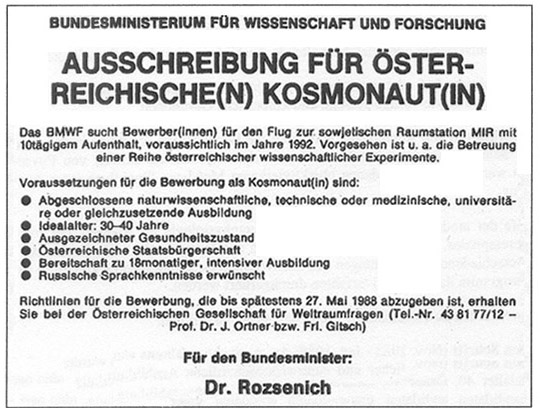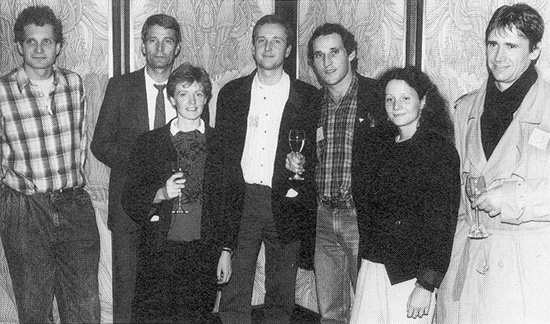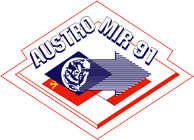Advertisement
On 9 April 1988 appeared an advertisement in the Austrian newspapers with a tender offer for an Austrian Cosmonaut. 220 people, 20 of them women, answered the advertisement from the Austrian Space Agency (ASA), which did the first preselection, and 198 came up the terms. From these people two should be selected as spacemen.

Team selection
Within one year 2 candidates should be selected from the 198 aspirants by a team of specialists for flight medicine, psychology and sports, assisted by medical specialists from all medical subjects and specialists from astronautics and project management.
Selection
The aspirants had to satisfy the requirements of jet pilots as the performance profil of a spaceman in West and East as well, and were selected through this philosophie under physical and psychological marginal tax burden. An university or equal professional was demanded, too. Further important requirements were emotional and group dynamical stability during the selection process on the one hand and on absolute mental and bodily healthiness on the other hand. The dialogue with the candidates and the observation of them during the different selection steps by the human factor experts as unit of the Physical-Psychical-Medicine was next to objective parameters the basic for the final decision.
The selection in a 10-steps-program was conducted with the support of modern equipement for air physiology abroad, the infrastructure of the army hospital, the university hospitals of the evangelic hospital in Vienna and diverse equipement from the Austrian armed forces.
The aspirants had to fulfil different requirements
In a first step (November 1988 – January 1989) 110 candidates were selected with following criteries: a maximum age of 40 years, Austrian nationality and scientific training. Medical history, radiographs, diagnostic findings, optical, otorhinolaryngology, dental, and ergometric findings of were regarded. Ultrasonic testings were additionally made.
The aspirants had to bring their old hospital findings, medical histories, character reference, copies of their certificates with them. They were proofed by the experts.
Each aspirant had to add a handwritten resume, 2 passport photographs, a detailled discription of his current job, the actual income and his or her salary requirement. They were introduced to the project planning, accommodation and holiday possibilities in Baikonur (the training center for the Soviet Cosmonauts).
The second step (January 1989 – February 1989) included physiological and medical pretests. 70 aspirants were meantioned as adequate.
The third step (February 1989) included a psychological preselection (4 hours teamwork, computertests) and the first personally interview (1 hour). These standardised dialogues were carried out by a doctor and a psychologist. During the interview were physiological measurements like breathing rate, pulse, blood preasure, clamminess of the skin etc. were taken and documented.
30 candidats were selected and climbed the next step.
The fourth step (March 1989 – April 1989) included the selection according to the physiological and the stress tolerance test criterias: the aspirants had to absolve a survival training sfter a drop.
The aspirants got a parachutist training from the training center Wiener Neustadt. After the drop they were set under diverse physical and psychological stress situations (they had to absolve under time pressure a 25 km long barrier lane, a recognition game, transport of the injured, making fire, abseiling, different performance tests, etc.). Every single person was individuell documentated per video and by the trainer. Psychologists and doctors observed the test and warranted the safety of the aspirants.
The next step was to fly with the left 30 candidates in military airport Brumowski for the first time with military airplanes (flights with jet and light-aeroplane each for half an hour).
They had to absolve a standardised flight program with exact repeated flight figures, regulary interviews about orentation, well-being, etc. at a speed up of +5.0 to -2.0 g and rapid altitude differences.
During this test various psychophysiological measurements (Holter-EKG, Voice-Recording, balance tests with Luzerner disc, pulmonary capacity tests, blood- and urine findings and blood pressure changes during and after the flight) were reported.
Another test was the 20 minutes lasting test on the lathe (speed up 180°/sek, every ten seconds bend forward up to horizontal, shift in direction every minute), after this 15 aspirants remained in the competition.
In the fifth step of the selection process (May 1989) the candidates had to undergo a underpressure-stress-test (Lower Body Negative Pressure, LBNP) at -100 Torr for 30 minutes. During this test the heart-circulation and the physiological exposure amplitude from the bloodvolume allocation between the upper and the lower bodyhalf (up to 2 liters) under strict medical and physiological observation is maximum fathom.
During the sixth selection step (May 1989) the clinical-psychological Selection at the Viennese Institute for applied Psychology in the form of written tests, with special Soviet tests for the Soviet spaceman, was made. All 13 candidates absolved the 2 days lasting test and remained in the competition.
The main medical test (complete interne medicine and all specialists examinations, anthropomorphometry, tomography, magnetic resonance imaging of the skull, elektrookulography, echocardiography including sleep deprivation for 54 hours and following EEG) was made in the army hospital, at university hospitals and in the evangelic hospital.
The psychological test before and following the sleep deprivation included among other things tests of the vigilance, spacial association, dispersal of attention in the cerebal cortex and the sensomotoric overall performance.
The experimenters and the psychologists under the direction of Prof. Dr. W. RIEDLER had enough oportunities to prove the qualification of the aspiriants in the interviews and tests.
Everyone of the remaining 13 aspirants passed the test.
At one man of the candidats a congenital heart defect was detected during the examination. He had to undertake himself a heart searchery quickly after that he recovered totally and got back his civile airworthy.
During the eight selection step five male and two femal candidates were selected on the basis of the data from the fifth, sixth and seventh selection step by ten Soviet humanfactor- and spaceflight experts.
Here they were:
- Mag. Manfred Jeitler
- Obst. Ltnt. Robert Haas
- Mag. Gertrud Waich
- Dr. Clemens Lothaller
- Dipl.-Ing. Franz Viehboeck
- Dipl.-Ing. Elke Griedl
- Mag. Peter Friedrich

The ninth selection step included an individuell fitness training, including endurance and power training, swimming and trampoline exercises observed by a fitness trainer that lasted for 10 weeks. All advances in progress were acquired and graphed.
After the tenth and last selection step (additional medical and flight physiological tests) in the Soviet Union four candidates (2 men and 2 women) and one male reserve candidate were elected and freed for the Cosmonautic training.
The Austrian side elected two candidates (Dipl.-Ing. Franz Viehboeck und Dr. Clemens Lothaller) definitly and sent them into the training in Baikonur in January 1990.
